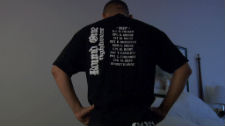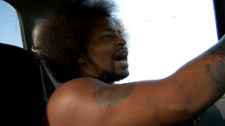HOW TO FOLD A FLAG Review

[How to Fold a Flag is now available to watch instantly streaming from Netflix and via VOD on iTunes, Hulu, VUDU, Cinema Now, Amazon.com, and other digital platforms.]
As the US relaxes into the Memorial Day weekend, How to Fold a Flag prods the nation to think about the true meaning of the holiday by profiling four men who served in Iraq. Filmmakers Petra Epperlein and Michael Tucker pick up their stories five years after documenting their experiences in their superb war documentary Gunner Palace. As one of them says, 'We served together for 15 months. Now we're alone.'
That's a common experience; we could say the same of any four people who have worked, schooled, or lived together for a period of years. The difference, of course, is that these four men faced life and death every day for 15 months. They saw their friends get killed; they killed other people.
We could say these four men are the lucky ones: they survived.
 Michael Goss, however, says that his "most important part" died in Iraq. He's haunted by the memory of the men who didn't make it, specifically, the men in his unit who were killed. Their names are stitched into a jockey that he wears, printed on a shirt that he holds dear. He describes them as ghosts, or spirits, whispering into his ear. He's a cage fighter now, earning a living the hard way to provide for his wife and four children, and he hears the whispers in the cage, telling him what to do.
Michael Goss, however, says that his "most important part" died in Iraq. He's haunted by the memory of the men who didn't make it, specifically, the men in his unit who were killed. Their names are stitched into a jockey that he wears, printed on a shirt that he holds dear. He describes them as ghosts, or spirits, whispering into his ear. He's a cage fighter now, earning a living the hard way to provide for his wife and four children, and he hears the whispers in the cage, telling him what to do.
After two tours of duty, Goss was suffering from depression and suicidal tendencies. He was given medication for his insomnia and cleared to carry a weapon. When he continued experiencing severe problems, he was drummed out of the service and given a dishonorable discharge; he thinks it was because the Army was convinced that providing him treatment for his battle-related mental health issues would be expensive, and there were already too many soldiers suffering from similar ailments.
 Javorn Drummond was one of them. He was diagnosed with Post-Traumatic Stress Syndrome, but given little assistance. He's a college student and works full-time nights at a hog factory. He lives in a dilapidated house in North Carolina, and he knows he needs to do better, telling the filmmakers: "Welcome to MTV Cribs -- Poor [N-Word] Edition."
Javorn Drummond was one of them. He was diagnosed with Post-Traumatic Stress Syndrome, but given little assistance. He's a college student and works full-time nights at a hog factory. He lives in a dilapidated house in North Carolina, and he knows he needs to do better, telling the filmmakers: "Welcome to MTV Cribs -- Poor [N-Word] Edition."
In Colorado, Stuart Wilf appears to be a cheerful soul, resigned to a low-income way of life because he refuses to do what he's qualified to do (i.e. be a soldier). His mother is a different story; her youngest son is preparing to return to military service, and she has difficulty dealing with highly-emotional prospect of losing another son, after suffering through prolonged anxiety about Stuart.
Jon Powers, the unit's former Captain who returned to the small town of Clarence (near Buffalo, New York) and started a charity to help Iraqi children from being recruited, has decided to run for Congress. He's under the impression that his military service should bolster his qualifications for public office, but finds that his millionaire opponents in the race are only too happy to pick away at his character through innuendo and insinuation.
Originating unofficially after the U.S. Civil War and known first as Decoration Day, the idea was to decorate the graves of those who had died in the conflict and thus honor their loss. After World War I, it was expanded to include all Americans who had died in war. It wasn't until 1971, however, that Congress declared Memorial Day to be a national holiday, conveniently scheduled as part of a three-day weekend. Nowadays, it's viewed as the unofficial start of summer. (Movie fans know that the first weekend of May signals the start of the summer movie season.)
The idea of honoring, and remembering, those who gave their lives in defense of their country has been somewhat lost on the nation at large, for whom the three-day weekend is a time for barbecues, picnics, fireworks, and, of course, military-honoring movies like The Hangover 2 and Kung Fu Panda 2. (Am I missing a connection to World War II there?)
More seriously, How to Fold a Flag touches on the issue by pointing out the serious, lingering problems suffered by soldiers long after their return from battle. It ties the whole thing together with intermittent footage on a soldier diligently learning how to fold an American flag -- it's quite a complicated process -- as part of the memorial service offered to the soldiers who return home only to be buried.
Filmmakers Epperlein and Tucker are very talented at allowing their subjects to speak their minds sufficiently so we get a true sense of their personalities, while also including interviews with other people that shed light on the challenges facing the veterans. It all coalesces together into an indelible portrait of four individuals who were ready to give their lives in behalf of their ideals.
It's up to everyone else to decide how they are to be honored.
How to Fold a Flag
Director(s)
- Petra Epperlein
- Michael Tucker
Writer(s)
- Michael Tucker (screenplay)
Cast
- Javorn Drummond
- Michael Goss
- Jon Powers
- Stuart Wilf








